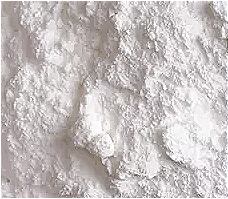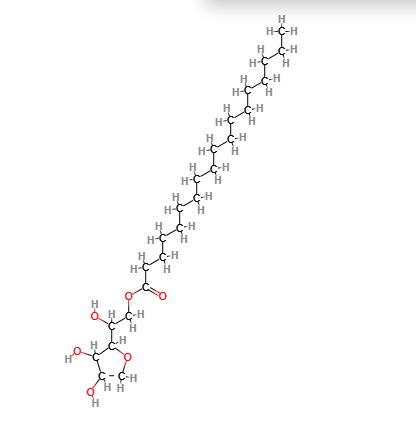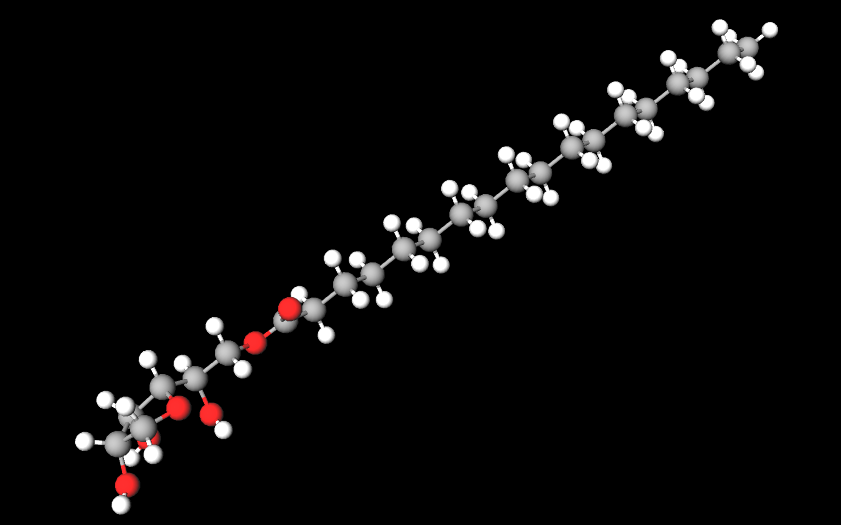| "Descrizione" di CarPas (5257 pt) | 20-mag-2024 17:46 |
Consenso relazione: 8 Media gradimento: 8 Numero utenti: 1
| Valutazione | N. Esperti | Valutazione | N. Esperti |
|---|---|---|---|
| 1 | 6 | ||
| 2 | 7 | ||
| 3 | 8 | ||
| 4 | 9 | ||
| 5 | 10 |
E491 (Sorbitan monostearate) is a chemical compound, the monoester of stearic acid and hexitol anhydrides derived from sorbitol. Sorbitol esters are mono-, di- and triesters of fatty acids and hexitol anhydrides and are derived from sorbitol.
It appears as a white or yellowish powder.

What it is used for and where
Cosmetics
It is a hydrophobic non-ionic surfactant, gelling a number of organic solvents such as hexadecane, isopropyl myristate and a range of vegetable oils.
Sorbitan Stearate is derived from the esterification of stearate with sorbitol and is known for its ability to create stable emulsions between water and oil. This emulsifier helps to maintain the miscibility of ingredients that would otherwise separate, enhancing the texture and tactile feel of products. It is widely used in creams, lotions, foundations, and sunscreen products, where it provides a soft and smooth sensation on the skin. Additionally, Sorbitan Stearate helps to improve the skin barrier and prevent moisture loss,
Surfactant - Emulsifying agent. Emulsions are thermodynamically unstable and are used to soothe or soften the skin and emulsify, so they need a specific, stabilising ingredient. This ingredient forms a film, lowers the surface tension and makes two immiscible liquids miscible. A very important factor affecting the stability of the emulsion is the amount of the emulsifying agent. Emulsifiers have the property of reducing the oil/water or water/oil interfacial tension, improving the stability of the emulsion and also directly influencing the stability, sensory properties and surface tension of sunscreens by modulating the filmometric performance.
From the point of view of health safety, no problems were highlighted.
Food
Ingredient included in the list of European food additives as E491, with an emulsifying function.
Medical
Sorbitan monostearate-based organogels have also been developed for pharmaceutical applications (1).
Sorbitan monostearate can increase the loading capacity of drugs in lipid polymer nanocapsules (2).
 |  |
Molecular Formula C24H46O6
Molecular Weight 430.626
CAS 1338-41-6, 5093-91-4, 56451-84-4
Synonyms :
Span 60, Sorbitan stearate, FEMA 3028, Arlacel 60
References______________________________________________________________________
(1) Peyronel F, Marangoni AG. In search of confectionary fat blends stable to heat: hydrogenated palm kernel oil stearin with sorbitan monostearate. Food Res Int. 2014;55:93–102. doi: 10.1016/j.foodres.2013.10.036.
Abstract. The potential of sorbitan monostearate (SMS) addition to change the basic-crystal-structure of a confectionary fat blend (CFB) with the aim to enhance its heat resistance was investigated. The CFB used in this study was a blend of hydrogenated palm kernel oil stearin, lecithin, polyglycerol polyricinoleate (PGPR) and cocoa butter. Samples made with different proportions of SMS to CFB were prepared and the crystal structure, the melting behaviour, the crystal morphology and crystallization kinetics were studied. Heat resistance was evaluated using a temperature-variable rheological method. Powder X-ray diffraction (XRD) studies in the wide angle region (WAXS) revealed the presence of two crystalline polymorphs (α and β′) in all blends. While XRD studies in the small angle region (SAXS) revealed a shift in the CFB peak position upon addition of SMS. The presence of two polymorphic forms was confirmed by differential scanning calorimetry (DSC), while a third endotherm was evident when the amount of SMS present in the system was greater than 40%. Studies on the nucleation and crystallization kinetics showed that crystal nucleation and growth occurred in two stages: SMS appeared first followed by CFB. Iso-solid diagrams constructed from the melting profiles obtained from SFC-temperature measurements indicated monotectic solution behaviour between SMS and the CFB. The microstructure, as observed under polarized light, changed from small crystals for the CFB to needles for mixtures with 10% SMS, to spherulites for mixtures with 50% SMS, to clusters for mixtures containing between 80 and 100% SMS. Cryo-TEM showed nanoplatelet formation for the CFB and nano-blobs for SMS. The storage modulus (G′) for mixtures containing 25% SMS decreased from G′ = 1.72 107 ± 4.60 106 Pa at 20 °C to G′ = 3.24 105 ± 2.15 104 Pa at 40 °C. Thus, SMS addition to confectionery fats can provide heat resistance to the CFB.
(2) Poletto FS, De Oliveira CP, Wender H, Regent D, Donida B, Teixeira SR, Guterres SS, Rossi-Bergmann B, Pohlmann AR. How Sorbitan Monostearate Can Increase Drug-Loading Capacity of Lipid-Core Polymeric Nanocapsules. J Nanosci Nanotechnol. 2015 Jan;15(1):827-37. doi: 10.1166/jnn.2015.9182.
Abstract. Lipid-core polymeric nanocapsules are innovative devices that present distinguished characteristics due to the presence of sorbitan monostearate into the oily-core. This component acted as low-molecular-mass organic gelator for the oil (medium chain triglycerides). The organogel-structured core influenced the polymeric wall characteristics disfavoring the formation of more stable polymer crystallites. This probably occurred due to interpenetration of these pseudo-phases. Sorbitan monostearate dispersed in the oily-core was also able to interact by non-covalent bonding with the drugs increasing the drug loading capacity more than 40 times compared to conventional nanocapsules. We demonstrated that the drug-models quercetin and quercetin pentaacetate stabilized the organogel network probably due to interactions of the drug molecules with the sorbitan monostearate headgroups by hydrogen bonding.
| Valuta |
